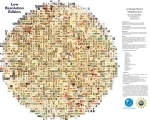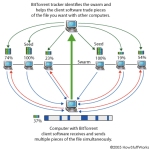
IDEO homepage (2008)
—
In the previous class we started to understand the relationship existing between the big group and the individual (up so far, mainly understood as an individual who works within a larger group). This class mainly refers to the mechanisms of production, systems that are basically”big groups” but function as a constellation of smaller entities.
If we look at the world of design the two main examples (big groups working as a network of smaller ones) are definitely IDEO and Arup.

Arup Sport, Beijing National Stadium structural render

IDEO‘s team work based design session
—
Two multinational companies organizing work on very different principles compared to the standard established by Henry Ford at the beginning of the last century (and then subsequently refined with the theories of Frederick Taylor, the Toyota “Lean Manufacturing” and another endless refinements to the original Fordist system to produce goods.

Ford Assembly line, (ca. 1913)
—
Having to describe briefly what is Arup, the easiest thing to do is to quote directly from Wikipedia:
Arup is a professional services firm providing engineering, design, planning, project management and consulting services for all aspects of the built environment. The firm is present in the Americas, Australasia, East Asia, Europe, Middle East and Africa, and now has over 10,000 staff based in 92 offices in 37 countries. Projects have been undertaken in more than 160 countries.
The firm was founded in Ireland 1946, as Ove N. Arup, Consulting Engineers by Sir Ove Nyquist Arup. Sir Ove set out to build a firm where professionals of diverse disciplines could work together to produce projects of greater quality than was achievable by them working in isolation. In 1963, together with the architect Philip Dowson, Arup Associates was formed to offer multi-disciplinary architectural and engineering services. In 1970, the firm reformed as “Ove Arup & Partners” and in the same year, Ove Arup delivered what is known as “The Key Speech“, setting out the values and future vision for Arup.
Arup has no shareholders or external investors, and is owned wholly by trusts whose beneficiaries are its past and present employees who receive a share of the firm’s operating profit each year.
Without entering the details of the infinite amount of work developed by Arup over the years (we can just remind the Centre Pompidou in Paris, the National Stadium in Beijing, the Kansai Airport in Osaka and the Sydney Opera House), one of the paragraphs of the above mentioned Key Speech by the late Ove Arup, deserves to be transcribed:
There are two ways of looking at the work you do to earn a living:
One is the way propounded by the late Henry Ford: Work is a necessary evil, but modern technology will reduce it to a minimum. Your life is your leisure lived in your ‘free’ time.
The other is: To make your work interesting and rewarding. You enjoy both your work and your leisure. We opt uncompromisingly for the second way.
There are also two ways of looking at the pursuit of happiness:
One is to go straight for the things you fancy without restraints, that is, without considering anybody else besides yourself. The other is: to recognise that no man is an island, that our lives are inextricably mixed up with those of our fellow human beings, and that there can be no real happiness in isolation. Which leads to an attitude which would accord to others the rights claimed for oneself, which would accept certain moral or humanitarian restraints.
We, again, opt for the second way.

Jørn Utzon, Ove Arup & Partners, “Sydney Opera House“, 1973

Renzo Piano, Richard Rogers, Ove Arup & Partners, “Centre George Pompidou” (“Beaubourg”), Paris, 1971/77

RPBW (Renzo Piano Building Workshop), Ove Arup & Partners, “Kansai Airport“, Osaka, 1994

Herzog & de Meuron, ArupSport, China Architectural Design & Research Group, Ai Weiwei (artistic consultant), “Beijing National Stadium“, 2003/8
Obviously, to manage to have a working system exciting and rewarding for more than ten thousand people (all of whom must be gratified, even messengers, secretaries, etc.), the system itself must be incredibly sophisticated . The cornerstone of everything is the team (at Arup there is a true obsession for the concept of “team”), an attitude openly defined “humanist” (implying a system where human relationships are always at the center of the relation network).
To overlap in a sensible and sensitive way the “hard” constraints typical of a big corporations (just think the financial flow you need to pay a monthly salary to 10.000 people) with a set of “soft” values related to the welfare and well-being of the workers is one of the great results (usually unnoticed) in the Arup way-of-doing, and it makes the company as a great case study.
Compared to a world that seems more and more standardized without other real options than the “big business”ones, here we are facing a different way to be active in the design world on a mass scale.
Just think about the smart mechanism upon which the company is owned exclusively by people who work there (in different proportions upon to the role you have in it). When you are hired, you get a share of the company stocks (and when you leave or retire, you give them back).
Moving to IDEO, here again it can be useful to quote the entry in Wikipedia for a concise description:
IDEO is a design and innovation consultancy based in Palo Alto, California, United States with other offices in San Francisco, Chicago, New York, Boston, London, Munich and Shanghai. The company helps design products, services, environments, and digital experiences. Additionally, the company has become increasingly involved in management consulting.
The firm employs approximately 550 people in the disciplines of human factors, mechanical, electrical and software engineering, industrial design, and interaction design. IDEO has worked on thousands of projects for a large number of clients in the consumer, computer, medical, furniture, toy, office and automotive industries. Notable examples are Apple’s first mouse, Microsoft’s second mouse, the Palm V PDA, and Steelcase’s Leap chair. Major clients (as of 2004) included Procter & Gamble, PepsiCo, Microsoft, Eli Lilly, and Steelcase.
Let’s think for a moment about the first mouse on the market: it is the mouse to the Apple Lisa (1983). Developed on the basis of experiments in the 70s at Xerox Parc by Hovey-Kelley.

Apple Lisa mouse, (Hovey-Kelley Design and Apple), 1983
—
Are we still able to remember a world in which computers didn’t have any “wimp” (window, icon, menu, pointing device)? Computers without a mouse? Until 1984 (year when first released for the Apple Macintosh), the only way to interact with a computer was using the keyboard…
;o

Xerox 8010 Star Information System (First WIMP graphical interface), 1981
—
Back to IDEO, like for Arup, the cornerstone of the whole system refers to the teamwork and the sophisticated relationship between the individual and the group.
Every person in the company is part of different teams according to the different needs of the various projects. Particularly fascinating is the blackboard where you see at a glance the various people (in the form of a card with their skills and the percentage of their time allocated to the various projects), their timelines and the overall grid with the various projects.
With a simple glance you have an understanding of what is happening, the projects on track, who are the people who are working there and if whom to ask for the new upcoming project.
One version even more extreme of the flexible organization of IDEO (you don’t belong to a department but you work with different teams upon differen projects) is the typical big American architecture office (like SOM), where instead of a desk you have a trolley and you spend your time moving from meeting to meeting as the daily routines unfold.

IDEO methods
—
Bruce Nussbaum, having to explain the reasons for the excellent performances and results of IDEO lists a number of factors, out of which we point to the ones more relevant to our conversation:
– Teamwork
– New approaches for each project.
– IDEO sells the business skills revealing methods and results in books and publications
– The innovation process is defined through multifunctional teams succesfully developing successive prototypes directly tested with users.
– IDEO teaches anyone the “how to”
The most interesting element is precisely this teamwork with teams reinvented from time to time depending on the various needs (henceforth the single person can be part of different teams at the same time). The various project teams are assembled and disassembled as LEGO bricks, based on skills and needs.
By the way this way of organizing the work is an American version of the traditional Italian production district. On this matter, Roberto Verganti (Politecnico di Milano) wrote extensevely.
What in IDEO is a product of a carefully organized process, in Italy happens as a spontaneous process. In this extent we could say that David Kelley, Bill Moggridge and the other IDEO people have tied together an artificial industrial cluster.
In a country like Italy the typical industrial cluster result (generally) in one specific kind of physical production (shoes in Marche, chairs in Udine, cars in Torino, furnitures in Brianza, etc). The IDEO model is actually much stronger because is not directly related to physical production and can range on a 360 degrees angle.
Another important element of IDEO process is this attention on making the whole creative process visible. To spit every single step of the design process and make it visible is a form of communication, a tool to communicate and make clear to the big companies why they should pay an high value for “design”. IDEO is excellent on explaining to their client why they have to spend their money (generally a lot) investing on design, how this money is spent, and (foremost) that there is a logical formula for innovation, success and creativity.
IDEO makes clear that there is no magic, no intuition, just hard work. A formula (recipe) that can be shared, communicated, thought and sold to all companies interested.
Finally, it is obvious that there is an analogy between the traditional Italian system to produce goods and to make innovation and the IDEO one, still we are facing two different approaches (in the American case the end result is the result of an intentional process, while in the Italian case we have interesting results of a series of processes unplanned but linked through centuries of local experience).
Think for instance to the Benetton production system where the “factory” is actually a shipping hub where you collect the production made by thousands and thousand small family-based sweatshops. Benetton was smart to understand how the local system works, and they did develop a production mode perfectly fitting the local habits and social attitudes (carefully leveraging on the relationship between the big and small group). IDEO inventeda new reality made out of new social and productive systems and tools.

Ideo, “Method Cards“, 2002
—
IDEO has this curious skill to be very easy to be copied, yet no one is able to copy it. Paradoxically IDEO communicates at lenght what/how/why they do. Books, movies, documentaries, even a deck of cards for the lazy ones. Finally no one is able to replicate that same model.
What is the hidden magic, if any?
And you, dear student, if you were to imagine your IDEO for the future, what would you do? Which direction would you take?

One of the project rooms in IDEO, Palo Alto, where brainstorm notes are documented evidence of the creative energy generated by the team.
—
Name and things useful + important (to be remembered for the exam):
– Arup
– Fordism
– IDEO
– Industrial cluster
– Lean Manufacturing (Just-in-time)
– Xerox Parc
ps: In this post we made reference to some of the most important contemporary architecture offices. Here you have the relevant links:
– Herzog & de Meuron
– RPBW (Renzo Piano Building Workhsop)

Jacques Herzog, Pierre de Meuron, “Allianz Arena”, Munich, Germany, 2005


























































































































